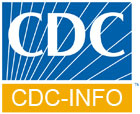Skip directly to the search box, site navigation, or content.
Division of Foodborne, Bacterial and Mycotic Diseases (DFBMD)
Salmonellosis
More information about Salmonellosis and related outbreaks may be found on the Salmonella Topic Page
Clinical Features
Diarrhea (sometimes bloody), fever, and abdominal cramps. Occasionally can establish localized infection (e.g., in a joint) or enter the blood.
Etiologic Agent
Enterobacteriaceae of the genus Salmonella, a gram-negative rod-shaped bacilli. Approximately 2000 serotypes cause human disease.
Incidence
An estimated 1.4 million cases occur annually in the United States; of these, approximately 40,000 are culture-confirmed cases reported to CDC.
Sequelae
Estimated 400 fatal cases each year; a few cases are complicated by chronic arthritis.
Transmission
Contaminated food, water, or contact with infected animals.
Risk Groups
Affects all age groups. Groups at greatest risk for severe or complicated disease include infants, the elderly, and persons with compromised immune systems.
Surveillance
National surveillance is conducted through the public health laboratories for culture-confirmed cases and through the National Notifiable Diseases Surveillance System (NNDSS). Active laboratory- and population-based surveillance is conducted in FoodNet sites.
Trends
Salmonella serotypes Enteritidis, Typhimurium, and Newport account for about half of culture-confirmed Salmonella isolates reported by public health laboratories to the National Salmonella Surveillance System. The proportion of Salmonella infections that were Enteritidis increased markedly from 1980 to 1995, but declined 34% from 1995 to 2006. Typhimurium has been the most common serotype since 1997. The proportion of Salmonella infections that were Typhimurium decreased 28% from 1996 to 2006. Resistance to at least five antimicrobial agents is common in Salmonella Typhimurium. Salmonella Newport increased markedly since 1995 and it is now the third most frequent serotype. Salmonella Newport strains resistant to at least 7 antimicrobial agents (MDR-AmpC) have been identified in isolates from humans.
Challenges
Identifying unrecognized major sources of Salmonella infections; determining the sources of Salmonella infections in infants; preventing contamination of vegetables with manure from concentrated animal feeding operations; preventing further emergence of highly resistant strains; controlling Salmonella Enteritidis infections through changes in the egg industry and education of food service workers and consumers; and developing effective education methods and materials to prevent reptile-associated salmonellosis.
Opportunities
Improving detection of dispersed outbreaks through collaborations among PulseNet laboratories and OutbreakNet epidemiologists; training state health department personnel in Salmonella serotyping; and encouraging judicious use of antimicrobial agents in veterinary medicine.
Content Source: National Center for Zoonotic, Vector-Borne, and Enteric Diseases (ZVED)
Program Contents
Contact Information

